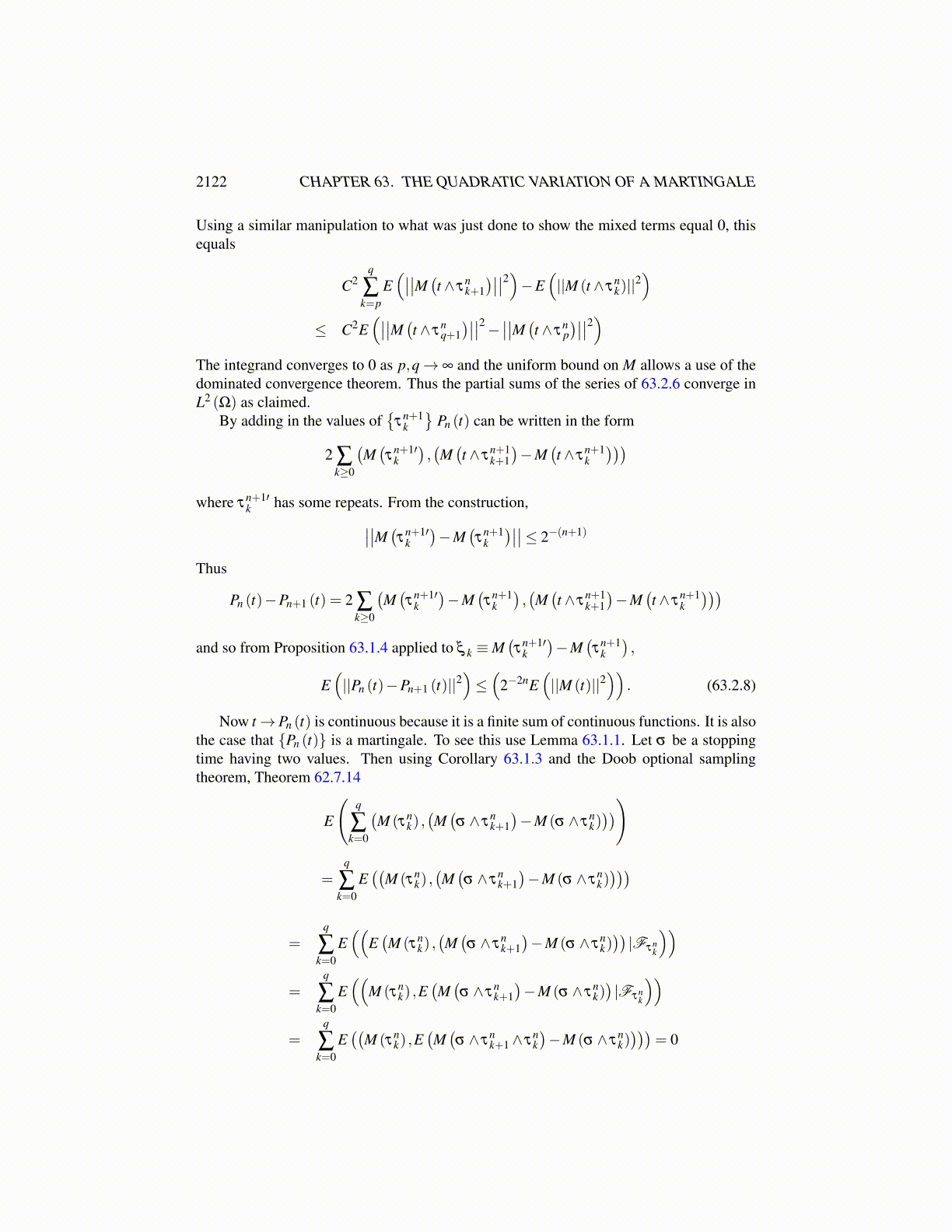
2122 CHAPTER 63. THE QUADRATIC VARIATION OF A MARTINGALE
Here is why. The sequence{
τnk (ω)
}∞
k=1 eventually equals T for all n sufficiently large.This is because if it did not, it would converge, being bounded above by T and then bycontinuity of M,
{M(τn
k (ω))}∞
k=1 would be a Cauchy sequence contrary to the requirementthat ∣∣∣∣M (τn
k+1 (ω))−M (τn
k (ω))∣∣∣∣
=∣∣∣∣M (ηn
k+1 (ω))−M (ηn
k (ω))∣∣∣∣= 2−n.
Note that if δ is any stopping time, then∣∣∣∣M (t ∧δ ∧ τnk+1)−M (t ∧δ ∧ τ
nk)∣∣∣∣
=∣∣∣∣∣∣Mδ
(t ∧ τ
nk+1)−Mδ (t ∧ τ
nk)∣∣∣∣∣∣≤ 2−n
You can see this is the case by considering the cases, t ∧ δ ≥ τnk+1, t ∧ δ ∈ [τn
k ,τnk+1), and
t ∧ δ < τnk . It is only this approximation property and the fact that the τn
k partition [0,T ]which is important in the following argument.
Now let αn be a localizing sequence such that Mαn is bounded as in Proposition 63.2.2.Thus Mαn (t) ∈ L2 (Ω) and this is all that is needed. In what follows, let δ be a stoppingtime and denote Mα p∧δ by M to save notation. Thus M will be uniformly bounded andfrom the definition of the stopping times τn
k , for t ∈ [0,T ] ,
M (t)≡ ∑k≥0
M(t ∧ τ
nk+1)−M (t ∧ τ
nk) , (63.2.4)
and the terms of the series are eventually 0, as soon as ηnk = ∞.
Therefore,
||M (t)||2 =
∣∣∣∣∣∣∣∣∣∣∑k≥0
M(t ∧ τ
nk+1)−M (t ∧ τ
nk)
∣∣∣∣∣∣∣∣∣∣2
Then this equals= ∑
k≥0
∣∣∣∣M (t ∧ τnk+1)−M (t ∧ τ
nk)∣∣∣∣2
+ ∑j ̸=k
((M(t ∧ τ
nk+1)−M (t ∧ τ
nk)),(M(t ∧ τ
nj+1)−M
(t ∧ τ
nj)))
(63.2.5)
Consider the second sum. It equals
2 ∑k≥0
k−1
∑j=0
((M(t ∧ τ
nk+1)−M (t ∧ τ
nk)),(M(t ∧ τ
nj+1)−M
(t ∧ τ
nj)))
= 2 ∑k≥0
((M(t ∧ τ
nk+1)−M (t ∧ τ
nk)),
k−1
∑j=0
(M(t ∧ τ
nj+1)−M
(t ∧ τ
nj)))
= 2 ∑k≥0
((M(t ∧ τ
nk+1)−M (t ∧ τ
nk)),M (t ∧ τ
nk))